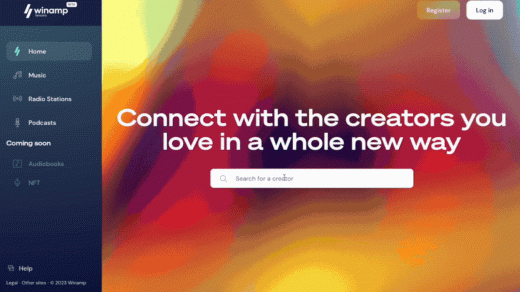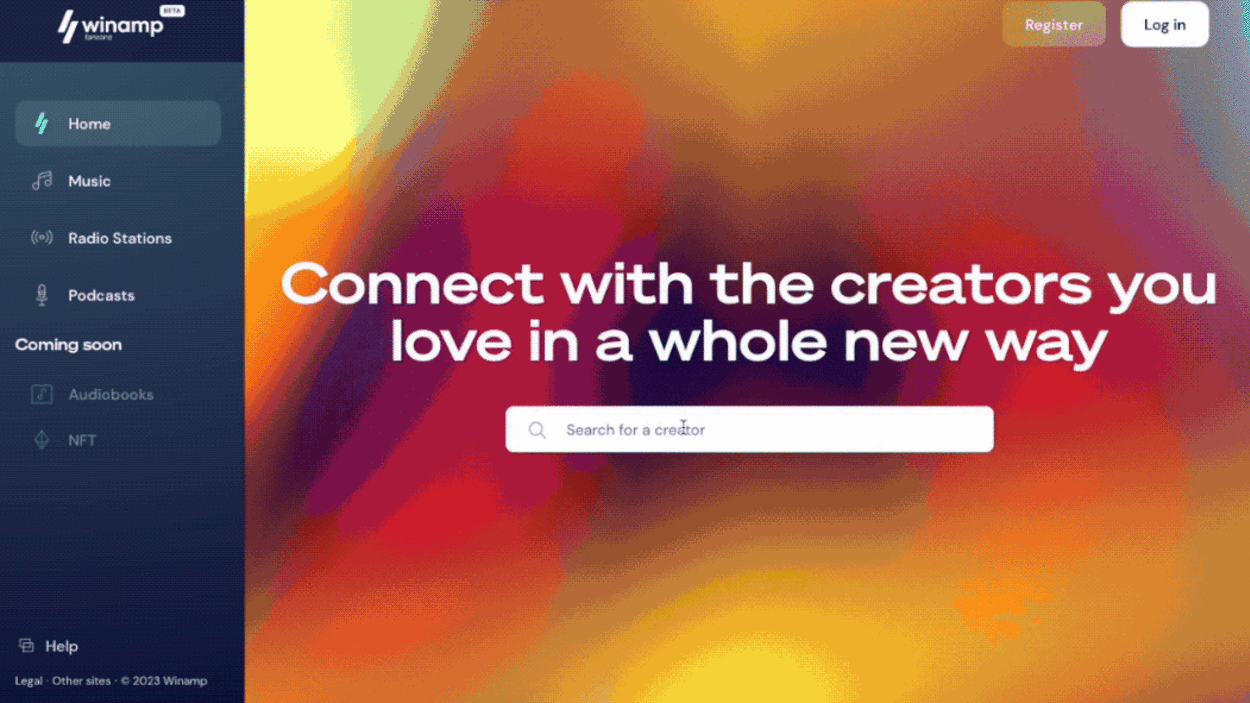Winamp is back, but not like you remember
After 25 years and numerous changes in ownership, Winamp is trying to reinvent itself.
The classic music player, which rose to prominence during the heyday of MP3 sharing-services such as Napster and Kazaa, has a new version out today that looks and acts nothing like its former self. Instead, Winamp’s new web software will serve primarily as an aggregator of online-audio sources and a way for creators to connect with fans.
The old version of Winamp isn’t going away—it’s been surprisingly resilient, with 83 million monthly active users worldwide—but its usage is in decline. The reboot is an attempt by Winamp’s current owner, Brussels-based Llama Group, to reach an audience that may be too young to even know about the software’s MP3 roots.
“We definitely want to keep and provide satisfaction to the community,” says Thierry Ascarez, Winamp’s chief commercial officer, “but we also want to evolve and provide something for the new generation.”
An all-in-one audio app (eventually)
At launch, Winamp’s new version is only available on the web, and with limited capabilities. Users can stream from internet radio stations and listen to podcasts, and they can connect with individual creators who’ve signed into the platform.
In Q3, Winamp plans to launch mobile apps for iOS and Android, along with the ability to play local audio files. Desktop apps for Windows and Mac will arrive in Q4.
Long-term, Winamp plans to be a hub for all kinds of audio sources. Alongside local audio playback, it’s planning to integrate with streaming music services such as Spotify in Q4, allowing users to access their playlists without leaving Winamp. Support for audiobooks is also in the works, though the company hasn’t made any agreements with catalog owners yet.
“In the past, it was in the DNA of Winamp to read any format, so we’ve tried to keep that same spirit with the current player to access any audio services,” Ascarez says.
A Patreon alternative
A lot still has to happen for Winamp to make good on its plans, but by giving users a convenient place to access their audio, Winamp hopes to attract more creators to the platform as well.
A key piece of Winamp’s new version is the “Fanzone,” a Patreon-like service where listeners can buy perks, such as early access to songs or exclusive NFTs. Creators can sell these products though the Fanzone, while also using Winamp to manage copyrights, license their songs for commercial use, and distribute music to services such as Spotify.
“It’s really that model of offering them a marketplace to become better merchants,” Ascarez says.
In exchange, Winamp will take a cut of revenues—including 15% for direct fan subscriptions—and charge artists $55 per year after the first year. That’s more than the costs of Patreon, whose main plan takes an 8% revenue cut with no annual fees, but Winamp is also offering more services in one place and a greater focus on music overall. Ascarez believes this will appeal to musicians, as many of them struggle to earn a living from streaming (and, increasingly, from touring as well).
“They are in need of a new model because the streaming world is not enough for them,” he says.
Rocky road
Winamp’s path to this point has certainly been circuitous. AOL, which acquired Winamp’s original owner Nullsoft in 1999, had planned to discontinue the software at the end of 2013. Instead, it was acquired by Radionomy, an online radio provider that was mainly interested in Winamp’s companion Shoutcast radio service.
After migrating Winamp’s technology over from AOL—a process that itself took a year and a half—Radionomy considered launching a Winamp-branded streaming service akin to Spotify. Alexandre Saboundjian, Winamp’s CEO (and Radionomy’s CEO at the time), says the company ultimately decided against it due to those services’ unfavorable economics.
“The streaming platform is already a field with a lot of competition, and all these companies were not really in a healthy situation when we talk about finance,” Saboundjian says.
That decision effectively put Winamp on the backburner as Radionomy went through an series of corporate shifts. In 2020, it shut down its own internet radio service and rebranded as Shoutcast, which was the name of its platform for managing internet radio stations for other providers. Shoutcast then rebranded again as Targetspot, and in late 2022, sold its entire radio business to Azerion, a digital advertising platform.
The remaining company is now called Llama Group—a reference to Winamp’s original mascot and slogan—and is publicly traded under ALLAM on the European stock exchange. Alongside Winamp itself, the company operates the royalty-free music licensor Jamendo and the copyright management service Bridger.
The new Winamp, then, is a kind of connective tissue. It gives musicians a marketplace for selling to fans while managing things like copyrights and royalties, for which they also might rely on Llama’s other services.
“We need to create again this direct relation between the fan and the artist, and this is the mission we have with Winamp,” Saboundjian says.
Preserving the past
The resulting mission brings Winamp far afield from what it’s been for the past 25 years. Instead of trying to build on its classic software, the new version of Winamp will merely allude to it, with features like local music playback and equalization.
“We definitely want to keep that irreverent spirit,” Ascarez says. “We’ve kept the llama, we’re keeping the equalizer. And our values: It’s really openness, empowerment, access, and simplicity.”
Still, managing a brand with such strong nostalgic value has its challenges. Last year, for instance, Winamp sold an NFT of the software’s original “skin”—in classic Winamp, skins are ways to customize the player’s look—and planned to steer the proceeds toward its nascent music charity project. Instead, it cancelled the project in response to backlash. Ascarez recognizes that people with fond memories of Winamp were angry at the company for hopping on the NFT bandwagon, but hasn’t backed off the technology.
“We don’t consider Winamp at all to be a Web3 company, we just find the technology very interesting, and there is potential there,” he says.
At the same time, Winamp is still dependent on its existing 83 million users. Its largest market is Brazil, which accounts for 10.3% of the user base, followed by India (8%), Russia (6.5%), and the United States (5.8%).
While it’s often associated with MP3 playback, Winamp’s most-used feature is internet radio, and every week the company gets requests from radio stations that want to be listed in its station directory. Saboundjian says the new version of Winamp will include these stations, along with others that it gets through various databases.
All of which helps explain why the classic version of Winamp is staying put. Ascarez says Winamp will add some new features to it but won’t force users to adopt the new version. (There’s also a community-built lookalike with full plug-in support as an alternative.)
“The legacy player will stay like it is,” Ascarez says.
That promise should provide some comfort for diehard Winamp fans with their own personal music collections. The only difference now is that Winamp’s creators would prefer to move on.
(10)



